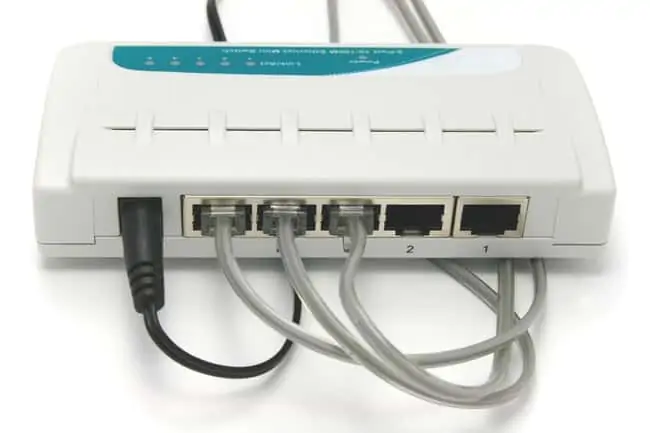It is a slightly more advanced home networking issue, but plenty of users want to know how to connect a Wi-Fi router to a switch, to add more connections to their home network. The process is pretty simple and quick.
Here are the steps to connect a router to a switch in quick form:
- Get any RJ-45 ethernet/LAN cable
- Plug one end into any LAN port on the router
- Plug the other end into any port on the switch
- The router and switch are now connected.
- You can then connect additional devices to the switch.
But we’ll go over each step in more detail with pictures so any user can know exactly what to do.
Step #1 – Plug a Network Cable Into A Router LAN Port
The back of a standard home Wi-Fi router usually has 5 ports on it – 4 LAN (local area network) ports and one WAN (wide area network) port.
The WAN port is usually set off a little from the others, and is often colored differently. Depending on whether your router and modem are combined into one, or separate, this port can also sometimes be called the DSL/ADSL/Internet/Broadband/Fiber port. See here for more on the different ports on routers.
Whatever it’s called, DON’T plug the switch into this WAN port; in any case, if your internet is working it should already have a cable plugged into it that goes directly into the phone line/master socket (for combined router-modems) or into the modem via ethernet if they are separate.
Instead, grab a standard RJ-45 ethernet/LAN cable and plug in into ANY of the 4 LAN ports (it doesn’t matter which).
Something like this:

Step #2 – Plug the Other End Into A Switch Port
There’s no need to differentiate between any of the ports on the switch as there is on a router, because all the ports on a switch are effectively LAN ports, since switches are local network devices only and can’t communicate between networks as routers can.
Switches are LAN devices, whereas routers are both WAN and LAN devices; see our comparison article on switches vs routers for more on this.
Therefore just pick any free port on the back of a switch and plug the other end of your network/LAN cable into it. Your router and switch are now connected!

Step #3 – Plug Additional Devices Into The Switch
Now that your router and switch are connected, you are free to plug additional devices by ethernet cable into the other free ports on the back of the switch.

The switch acts as an intermediary device, between these devices and router, ensuring data gets sent back and forth between the correct devices and the router. It manages data transfer on the home network, using MAC addresses to make sure that the correct data goes to the correct devices, and provides more ethernet ports.
What Is The Point Of Adding a Switch To A Home Network?
We just touched on the main reason why users add switches to home networks – to add more wired ethernet access points to the network; to plug more devices in by network cable if needed.
Remember that most standard Wi-Fi routers only provide 4 ethernet/LAN ports; if you need to plug in any more, you are out of luck on most routers.
Obviously many more devices can connect by Wi-Fi, but this isn’t always the best option for users who need a strong connection and low latency (gamers) or high bandwidth (streamers). Wi-Fi is often slower than ethernet (see here), so it’s preferable to go wired when possible.
Therefore switches open up the potential for more than 4 wired LAN connections on the home network if they are needed. See our article on the different options open to you if you’ve run out of ethernet ports on your router, with switches and other alternatives discussed.
Some Key Points on Routers vs Switches on a Home Network
Here are some key differences between switches and routers for home networks, plus some do’s and dont’s for using them :
- In simple terms a switch is designed to connect devices together within a single local network, whereas a router connects multiple different networks together.
- Switches can be used to extend or strengthen connectivity in local area networks (LANs) such as in homes, whereas routers connect local networks to broader networks such as the wider internet.
- In general only ever connect routers to switches to expand home networks, and never routers to routers unless you are advanced in home networking. Routers to routers can be done but needs some complex setup to work properly.
- You always need a router to use a switch on a home network; you can’t plug a switch into the phone line directly because it won’t work. Switches only forward data and cannot assign IP addresses like routers can.
- Multi-port ethernet switches are readily and cheaply available online; see this article for links to some good ones.
